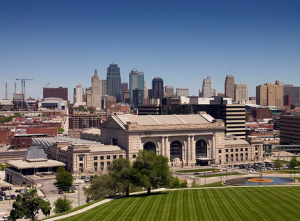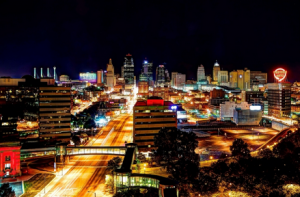Around the turn of the 20th century a national movement began, called City Beautiful. In an excerpt from “The City Beautiful Movement in Kansas City,” William Wilson writes, “The City Beautiful movement was fundamentally important to Kansas City. It remade an ugly boomtown, giving it miles of graceful boulevards and parkways flanked by desirable residential sections, acres of ruggedly beautiful parkland dotted with recreational improvements, and several neighborhood playgrounds in crowded districts.  Its results received attention and praise from city planners across the United States. It gave scope to the ambition and talent of George E. Kessler, whose success in Kansas City was the gateway to nationwide recognition in the professions of landscape architecture and city planning. Its boulevards helped define the natural demarcations among commercial, industrial, and residential sections, and were a boom to neighborhood stability in the years before effective zoning. It reached into every part of the city, establishing unity through its own pervasiveness. In later years, another set of city planners would find the much maligned City Beautiful architects had willed them a boulevard grid to ease the mounting loads of automobile traffic, had pointed the way to greater use of the park and boulevard system’s recreational opportunities and had left to them a precious legacy of urban beauty.” As a result of the City Beautiful Movement, Kansas City became a model for U.S. cities that wanted to create a more pleasant living environment, with boulevards such as the Paseo, Gladstone and Benton. Jesse Clyde Nichols was aware of the benefits of the movement when he created the Country Club Plaza, Mission Hills and Ward Parkway, which are still nationally regarded as treasures of city planning. J.C. Nichols became nationally regarded for his foresight in city development. Not only did he extend the City Beautiful concept to his own developments, he created a method of keeping integrity from one housing area to his next with the foresight to acquire land well beyond a current development, so that his next neighborhood would not only be contiguous, but also compatible with room for green space, churches and schools. He developed regional shopping areas, such as Brookside and Prairie Village, to service those neighborhoods, which are still some of the finest in the country.
Its results received attention and praise from city planners across the United States. It gave scope to the ambition and talent of George E. Kessler, whose success in Kansas City was the gateway to nationwide recognition in the professions of landscape architecture and city planning. Its boulevards helped define the natural demarcations among commercial, industrial, and residential sections, and were a boom to neighborhood stability in the years before effective zoning. It reached into every part of the city, establishing unity through its own pervasiveness. In later years, another set of city planners would find the much maligned City Beautiful architects had willed them a boulevard grid to ease the mounting loads of automobile traffic, had pointed the way to greater use of the park and boulevard system’s recreational opportunities and had left to them a precious legacy of urban beauty.” As a result of the City Beautiful Movement, Kansas City became a model for U.S. cities that wanted to create a more pleasant living environment, with boulevards such as the Paseo, Gladstone and Benton. Jesse Clyde Nichols was aware of the benefits of the movement when he created the Country Club Plaza, Mission Hills and Ward Parkway, which are still nationally regarded as treasures of city planning. J.C. Nichols became nationally regarded for his foresight in city development. Not only did he extend the City Beautiful concept to his own developments, he created a method of keeping integrity from one housing area to his next with the foresight to acquire land well beyond a current development, so that his next neighborhood would not only be contiguous, but also compatible with room for green space, churches and schools. He developed regional shopping areas, such as Brookside and Prairie Village, to service those neighborhoods, which are still some of the finest in the country. 
Photo credit: EEngler / Foter / CC BY-NC-SA
Unfortunately, those were not what we would call racially or religiously enlightened times. Both the Nichols Company and Kroh Brothers (developers of Leawood) used restrictive covenants running with the land to “protect” what they thought was a necessary component of their neighborhoods. These covenants often prohibited people of color or those of the Jewish faith from living in their developments. By the time the U.S. Supreme Court outlawed enforcement of those restrictions in the landmark case of Shelley v. Kraemer, in 1948, the practice was widely criticized throughout the country. The Shelleys were an African-American family in St. Louis, Mo. and their case was argued by future Supreme Court Justice Thurgood Marshall. The Court’s holding was that, although private developers could legally place such restrictive covenants in deeds, the courts could not be used to enforce those covenants under the Equal Protection Clause of the 14th Amendment to the U.S. Constitution, thereby eliminating their effectiveness. Lamentably, in Kansas City and elsewhere, the vestiges of those covenants have persisted until today. Affluent Jewish families tended to settle on the Missouri side of the state line well after the pernicious provisions were neutralized. Now both Jewish and African-American families may be found in Leawood and Mission Hills, but some disparities still remain. Although improving, our Metropolitan Area is still recognized as one of the more racially and religiously segregated cities in the country due to the controversial legacy of our past.

